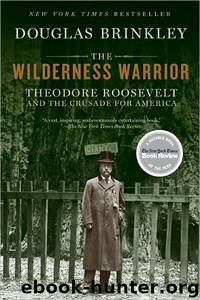The Wilderness Warrior by Douglas Brinkley

Author:Douglas Brinkley
Language: eng
Format: mobi, epub
Tags: Non-Fiction, Biography, History
ISBN: 9780060565312
Publisher: HarperCollins
Published: 2009-01-01T10:00:00+00:00
Warden Guy Bradley was murdered in Florida for trying to protect bird rookeries from plume hunters.
Warden Guy Bradley. (Courtesy of U.S. Fish and Wildlife Service)
The National Association of Audubon Societies (NAAS) immediately protested the cold-blooded murder of Guy Bradley, to draw even more attention to the menace of Florida’s rookery killers. Outraged, Roosevelt predictably promised not to cower or retreat in the face of the murder. Instead, he appointed more Department of Agriculture wardens in Florida (in a collaborative venture with the Audubon Society) and grew even more determined to create federal bird reservations (U.S. wildlife refugees) to protect cormorants, pelicans, herons, egrets, and other nongame birds. His belief in the Audubon Society’s mission, in fact, now increased tenfold. “Permit me on behalf of both Mrs. Roosevelt and myself to say how heartily we sympathize not only with the work of the Audubon Societies generally, but particularly in their efforts to stop the sale and use of the so-called ‘Aigrettes’—the plume of white herons,” Roosevelt wrote to Dutcher. “If anything, Mrs. Roosevelt feels more strongly than I do in the matter.”57
Recognizing that the concept of federal bird reservations was the best weapon against pluming, Dutcher staked NAAS’s future on creating sanctuaries like Pelican Island across America. Anger over Bradley’s death spun the feather wars plot. “If the National Association did no other work than to secure Bird Reservations and to guard them during the breeding season,” he said, “its existence would be fully warranted.”58
VII
There is no clear written record of how Paul Kroegel took the murder of Guy Bradley. All we know is that he retrieved the Audubon and continued to patrol Pelican Island in the boat he had built for Bradley. Flushed and confident in 1903 he boated out to Pelican Island with his aged father, Gotlobb, and posted two huge signs on the edge of Pelican Island, as instructed: “No Trespassing: U.S. Government Property.” They hoped these signs would deter plumers and others who would willfully or unknowingly harm the birds. Unfortunately, the huge signs had a deleterious effect on Pelican Island’s wildlife. In November–December 1903, the first winter after President Roosevelt’s “I So Declare It” decree, the birds abandoned the rookeries—they just didn’t show up. Pelican Island was an avian ghost town, with only three or four ruffled vultures poking around the mudflat. It turned out that the signs had intimidated the pelicans, preventing them from landing. Recognizing the mistake and determined to lure the leery birds back, Kroegel, with help from his father and with the concurrence of Frank Chapman, dismantled the billboards in 1904. And just like that, the pelicans returned.
Meanwhile, Chapman returned to Pelican Island in the spring of 1904, 1905, 1908, and 1914. True to form, he kept detailed records of the rookery and reported his findings directly back to Roosevelt, with a professional air.59 Chapman’s elegant black-and-white pictures from those sojourns, ideal for lantern-slide presentations, constituted a high-water mark of nature photography during the progressive era. Emotionally invested in Pelican Island, Chapman
Download
This site does not store any files on its server. We only index and link to content provided by other sites. Please contact the content providers to delete copyright contents if any and email us, we'll remove relevant links or contents immediately.
| U.K. Prime Ministers | U.S. Presidents |
Waking Up in Heaven: A True Story of Brokenness, Heaven, and Life Again by McVea Crystal & Tresniowski Alex(37676)
Empire of the Sikhs by Patwant Singh(22975)
We're Going to Need More Wine by Gabrielle Union(18970)
Hans Sturm: A Soldier's Odyssey on the Eastern Front by Gordon Williamson(18486)
Leonardo da Vinci by Walter Isaacson(13188)
The Radium Girls by Kate Moore(11922)
Tools of Titans by Timothy Ferriss(8219)
Educated by Tara Westover(7942)
How to Be a Bawse: A Guide to Conquering Life by Lilly Singh(7394)
Permanent Record by Edward Snowden(5742)
The Last Black Unicorn by Tiffany Haddish(5558)
The Rise and Fall of Senator Joe McCarthy by James Cross Giblin(5229)
Promise Me, Dad by Joe Biden(5088)
The Wind in My Hair by Masih Alinejad(5034)
A Higher Loyalty: Truth, Lies, and Leadership by James Comey(4846)
The Crown by Robert Lacey(4723)
The Iron Duke by The Iron Duke(4293)
Joan of Arc by Mary Gordon(4015)
Stalin by Stephen Kotkin(3879)
